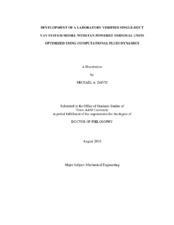| dc.contributor.advisor | O'Neal, Dennis | |
| dc.creator | Davis, Michael A. | |
| dc.date.accessioned | 2011-10-21T22:03:12Z | |
| dc.date.accessioned | 2011-10-22T07:09:19Z | |
| dc.date.available | 2011-10-21T22:03:12Z | |
| dc.date.available | 2011-10-22T07:09:19Z | |
| dc.date.created | 2010-08 | |
| dc.date.issued | 2011-10-21 | |
| dc.date.submitted | August 2010 | |
| dc.identifier.uri | https://hdl.handle.net/1969.1/ETD-TAMU-2010-08-8397 | |
| dc.description.abstract | Single Duct Variable Air Volume (SDVAV) systems use series and parallel Fan
Powered Terminal Units to control the air flow in conditioned spaces. This research
developed a laboratory verified model of SDVAV systems that used series and parallel
fan terminal units where the fan speeds were controlled by either Silicon Controlled
Rectifiers (SCR) or Electronically Commutated Motors (ECM) motors. As part of the
research, the model was used to compare the performance of the systems and to predict
the harmonics generated by ECM systems. All research objectives were achieved.
The CFD model, which was verified with laboratory measurements, showed the
potential to identify opportunities for improvement in the design of the FPTU and
accurately predicted the static pressure drop as air passed through the unit over the full
operating range of the FPTU.
Computational fluid dynamics (CFD) models of typical a FPTU were developed and
used to investigate opportunities for optimizing the design of FPTUs. The CFD model
identified key parameters required to conduct numerical simulations of FPTU and some of the internal components used to manufacture the units. One key internal component
was a porous baffle used to enhance mixing when primary air and induced air entered
the mixing chamber. The CFD analysis showed that a pressure-drop based on face
velocity model could be used to accurately predict the performance of the FPTU.
The SDVAV simulation results showed that parallel FPTUs used less energy overall
than series systems that used SCR motors as long as primary air leakage was not
considered. Simulation results also showed that series ECM FPTUs used about the same
amount of energy, within 3 percent, of parallel FPTU even when leakage was not considered.
A leakage rate of 10 percent was enough to reduce the performance of the parallel FPTU to the
level of the series SCR system and the series ECM FPTUs outperformed the parallel
FPTUs at all weather locations used in the study. | en |
| dc.format.mimetype | application/pdf | |
| dc.language.iso | en_US | |
| dc.subject | SDVAV | en |
| dc.subject | FPTU | en |
| dc.subject | VAV | en |
| dc.subject | single-duct variable air volume | en |
| dc.subject | EnergyPlus | en |
| dc.subject | CFD | en |
| dc.subject | series fan powered terminal unit | en |
| dc.subject | parallel fan powered terminal unit | en |
| dc.subject | system model | en |
| dc.title | Development of a Laboratory Verified Single-Duct VAV System Model with Fan Powered Terminal Units Optimized Using Computational Fluid Dynamics | en |
| dc.type | Thesis | en |
| thesis.degree.department | Mechanical Engineering | en |
| thesis.degree.discipline | Mechanical Engineering | en |
| thesis.degree.grantor | Texas A&M University | en |
| thesis.degree.name | Doctor of Philosophy | en |
| thesis.degree.level | Doctoral | en |
| dc.contributor.committeeMember | Bryant, John | |
| dc.contributor.committeeMember | Heffington, Warren | |
| dc.contributor.committeeMember | Rasmussen, Bryan | |
| dc.type.genre | thesis | en |
| dc.type.material | text | en |


